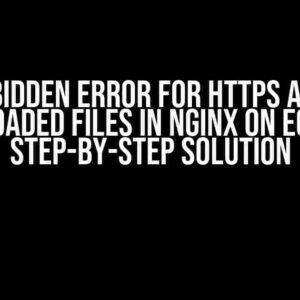Are you building a website that involves high-frequency message logs coming via websockets and displaying them on the UI? If so, you’re probably wondering which AWS EC2 instance is most suitable for your needs. In this article, we’ll dive deep into the world of EC2 instances and provide you with a clear guide on how to choose the perfect one for your high-frequency message logging website.
Understanding the Requirements
Before we dive into the nitty-gritty of EC2 instances, let’s understand the requirements of your website. You mentioned high-frequency message logs coming via websockets and displaying them on the UI. This means your website needs to handle:
- High-frequency message logs: Your website will receive a large number of messages in a short period, which requires fast processing and storage.
- WebSockets: Your website uses websockets to establish a real-time communication channel with clients, which demands low latency and high throughput.
- UI display: Your website needs to display the message logs in real-time on the UI, which requires fast rendering and processing.
EC2 Instance Types: A Brief Overview
AWS offers a wide range of EC2 instance types, each designed for specific workloads. When choosing an EC2 instance, you need to consider factors such as:
- CPU: The number of vCPUs and their processing power.
- Memory: The amount of RAM available for your application.
- Storage: The type and size of storage available for your data.
- Networking: The network performance and bandwidth available for your instance.
EC2 Instance Types for High-Frequency Message Logs
Based on your requirements, we’ll focus on EC2 instance types that excel in processing high-frequency message logs, handling websockets, and providing fast rendering for UI display.
Compute-Optimized Instances
Compute-optimized instances are designed for high-performance computing and are ideal for handling high-frequency message logs. These instances offer high vCPU counts, fast processing, and low latency.
| Instance Type | vCPUs | Memory (GiB) | Storage |
|---|---|---|---|
| C5 instances | up to 72 | up to 288 | EBS-only |
| C6 instances | up to 128 | up to 512 | EBS-only |
C5 and C6 instances are excellent choices for high-frequency message logs. They offer high vCPU counts, fast processing, and low latency. However, keep in mind that they don’t come with instance store, and you’ll need to use EBS storage for your data.
Memory-Optimized Instances
Memory-optimized instances are designed for applications that require large amounts of memory. They’re ideal for handling large datasets and are suitable for message logging applications.
| Instance Type | vCPUs | Memory (GiB) | Storage |
|---|---|---|---|
| R5 instances | up to 48 | up to 768 | EBS-only |
| R6 instances | up to 128 | up to 4096 | EBS-only |
R5 and R6 instances offer large amounts of memory, making them suitable for message logging applications. However, they have lower vCPU counts compared to compute-optimized instances.
Additional Considerations
When choosing an EC2 instance, don’t forget to consider the following:
- Networking: Ensure the instance type you choose has sufficient network bandwidth to handle the high-frequency message logs.
- Storage: Choose an instance type with suitable storage options, such as EBS or instance store, depending on your data requirements.
- Operating System: Ensure the instance type you choose supports your preferred operating system.
- Cost: Calculate the costs of the instance type based on your usage and budget.
Recommended EC2 Instance Types
Based on your requirements, we recommend the following EC2 instance types:
- C5 instances (c5.xlarge or c5.2xlarge) for high-frequency message logs and low latency.
- R5 instances (r5.xlarge or r5.2xlarge) for large message logging datasets and high memory requirements.
- C6 instances (c6.xlarge or c6.2xlarge) for high-performance computing and low latency.
- R6 instances (r6.xlarge or r6.2xlarge) for large message logging datasets and high memory requirements.
Conclusion
Choosing the right EC2 instance type for your high-frequency message logging website is crucial for its performance and scalability. By understanding your requirements and considering the various EC2 instance types, you can make an informed decision that meets your needs. Remember to consider factors such as CPU, memory, storage, and networking when selecting an instance type.
// Example of choosing an EC2 instance type using AWS CLI aws ec2 run-instances --image-id ami-abc123 --instance-type c5.xlarge --key-name my-key
By following this guide, you’ll be able to choose the perfect EC2 instance type for your high-frequency message logging website, ensuring fast processing, low latency, and efficient resource utilization.
Happy coding!
Frequently Asked Question
When it comes to hosting a website that involves high frequency message logs coming via websockets and displaying them on the UI, choosing the right AWS EC2 instance can be a bit overwhelming. Here are some questions and answers to help you make an informed decision:
What are the key factors to consider when selecting an EC2 instance for my website?
When selecting an EC2 instance, consider the CPU, memory, storage, and network requirements of your application. Since your website involves high frequency message logs and websockets, you’ll want an instance with high IOPS, low latency, and sufficient RAM to handle the volume of messages. Additionally, consider the instance’s network performance, as websockets require low latency and high throughput.
Would a general-purpose instance like the T3 or M5 instance be suitable for my website?
While general-purpose instances like T3 or M5 are cost-effective and provide a good balance of CPU, memory, and storage, they might not be the best choice for your website. Since your application involves high frequency message logs and websockets, you may benefit from an instance with higher IOPS and lower latency, such as an I3 or C5 instance.
What benefits do I3 instances offer for my website?
I3 instances are optimized for I/O-intensive workloads and provide high IOPS, low latency, and high storage capacity, making them an excellent choice for your website. They also support NVMe SSD storage, which can significantly improve the performance of your application.
Can I use a C5 instance instead, since they offer higher CPU performance?
While C5 instances do offer higher CPU performance, they might not be the best choice for your website if IOPS and storage capacity are your top priority. C5 instances are optimized for compute-intensive workloads, but they may not provide the same level of IOPS as I3 instances. However, if your application requires high CPU performance and can utilize the additional compute power, a C5 instance might be a good choice.
What about scalability and availability? Should I consider an Auto Scaling group or a load balancer?
Absolutely! Scalability and availability are crucial for a website that involves high frequency message logs and websockets. Consider using an Auto Scaling group to scale your instance fleet up or down based on demand. Additionally, use a load balancer to distribute incoming traffic across multiple instances, ensuring high availability and reducing the risk of instance failure.



